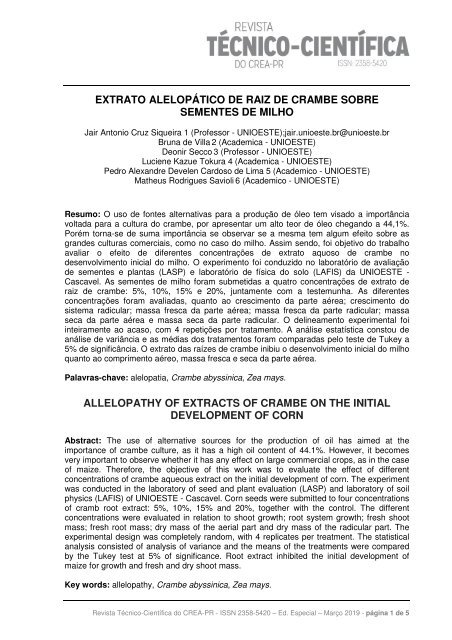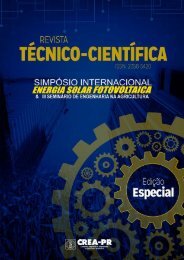Revista técnico cientifica crea
Create successful ePaper yourself
Turn your PDF publications into a flip-book with our unique Google optimized e-Paper software.
EXTRATO ALELOPÁTICO DE RAIZ DE CRAMBE SOBRE<br />
SEMENTES DE MILHO<br />
Jair Antonio Cruz Siqueira 1 (Professor - UNIOESTE);jair.unioeste.br@unioeste.br<br />
Bruna de Villa 2 (Academica - UNIOESTE)<br />
Deonir Secco 3 (Professor - UNIOESTE)<br />
Luciene Kazue Tokura 4 (Academica - UNIOESTE)<br />
Pedro Alexandre Develen Cardoso de Lima 5 (Academico - UNIOESTE)<br />
Matheus Rodrigues Savioli 6 (Academico - UNIOESTE)<br />
Resumo: O uso de fontes alternativas para a produção de óleo tem visado a importância<br />
voltada para a cultura do crambe, por apresentar um alto teor de óleo chegando a 44,1%.<br />
Porém torna-se de suma importância se observar se a mesma tem algum efeito sobre as<br />
grandes culturas comerciais, como no caso do milho. Assim sendo, foi objetivo do trabalho<br />
avaliar o efeito de diferentes concentrações de extrato aquoso de crambe no<br />
desenvolvimento inicial do milho. O experimento foi conduzido no laboratório de avaliação<br />
de sementes e plantas (LASP) e laboratório de física do solo (LAFIS) da UNIOESTE -<br />
Cascavel. As sementes de milho foram submetidas a quatro concentrações de extrato de<br />
raiz de crambe: 5%, 10%, 15% e 20%, juntamente com a testemunha. As diferentes<br />
concentrações foram avaliadas, quanto ao crescimento da parte aérea; crescimento do<br />
sistema radicular; massa fresca da parte aérea; massa fresca da parte radicular; massa<br />
seca da parte aérea e massa seca da parte radicular. O delineamento experimental foi<br />
inteiramente ao acaso, com 4 repetições por tratamento. A análise estatística constou de<br />
análise de variância e as médias dos tratamentos foram comparadas pelo teste de Tukey a<br />
5% de significância. O extrato das raízes de crambe inibiu o desenvolvimento inicial do milho<br />
quanto ao comprimento aéreo, massa fresca e seca da parte aérea.<br />
Palavras-chave: alelopatia, Crambe abyssinica, Zea mays.<br />
ALLELOPATHY OF EXTRACTS OF CRAMBE ON THE INITIAL<br />
DEVELOPMENT OF CORN<br />
Abstract: The use of alternative sources for the production of oil has aimed at the<br />
importance of crambe culture, as it has a high oil content of 44.1%. However, it becomes<br />
very important to observe whether it has any effect on large commercial crops, as in the case<br />
of maize. Therefore, the objective of this work was to evaluate the effect of different<br />
concentrations of crambe aqueous extract on the initial development of corn. The experiment<br />
was conducted in the laboratory of seed and plant evaluation (LASP) and laboratory of soil<br />
physics (LAFIS) of UNIOESTE - Cascavel. Corn seeds were submitted to four concentrations<br />
of cramb root extract: 5%, 10%, 15% and 20%, together with the control. The different<br />
concentrations were evaluated in relation to shoot growth; root system growth; fresh shoot<br />
mass; fresh root mass; dry mass of the aerial part and dry mass of the radicular part. The<br />
experimental design was completely random, with 4 replicates per treatment. The statistical<br />
analysis consisted of analysis of variance and the means of the treatments were compared<br />
by the Tukey test at 5% of significance. Root extract inhibited the initial development of<br />
maize for growth and fresh and dry shoot mass.<br />
Key words: allelopathy, Crambe abyssinica, Zea mays.<br />
<strong>Revista</strong> Técnico-Científica do CREA-PR - ISSN 2358-5420 – Ed. Especial – Março 2019 - página 1 de 5



